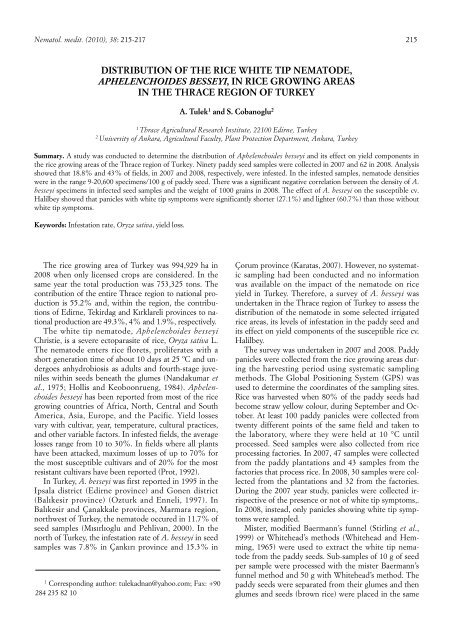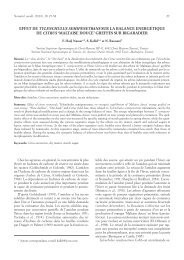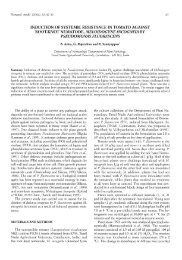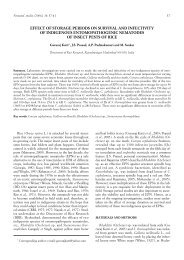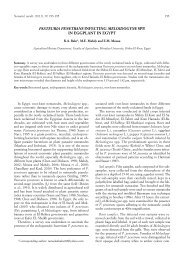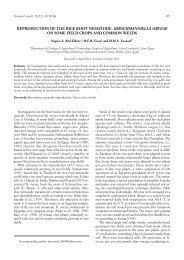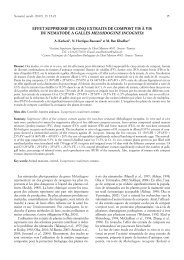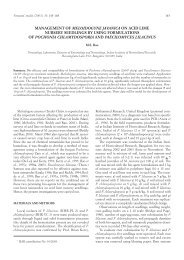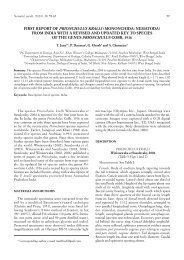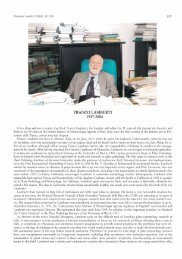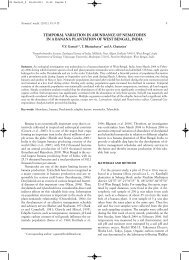distribution of the rice white tip nematode, aphelenchoides besseyi ...
distribution of the rice white tip nematode, aphelenchoides besseyi ...
distribution of the rice white tip nematode, aphelenchoides besseyi ...
Create successful ePaper yourself
Turn your PDF publications into a flip-book with our unique Google optimized e-Paper software.
Nematol. medit. (2010), 38: 215-217 215<br />
DISTRIBUTION OF THE RICE WHITE TIP NEMATODE,<br />
APHELENCHOIDES BESSEYI, IN RICE GROWING AREAS<br />
IN THE THRACE REGION OF TURKEY<br />
A. Tulek 1 and S. Cobanoglu 2<br />
1<br />
Thrace Agricultural Research Institute, 22100 Edirne, Turkey<br />
2<br />
University <strong>of</strong> Ankara, Agricultural Faculty, Plant Protection Department, Ankara, Turkey<br />
Summary. A study was conducted to determine <strong>the</strong> <strong>distribution</strong> <strong>of</strong> Aphelenchoides <strong>besseyi</strong> and its effect on yield components in<br />
<strong>the</strong> <strong>rice</strong> growing areas <strong>of</strong> <strong>the</strong> Thrace region <strong>of</strong> Turkey. Ninety paddy seed samples were collected in 2007 and 62 in 2008. Analysis<br />
showed that 18.8% and 43% <strong>of</strong> fields, in 2007 and 2008, respectively, were infested. In <strong>the</strong> infested samples, <strong>nematode</strong> densities<br />
were in <strong>the</strong> range 9-20,600 specimens/100 g <strong>of</strong> paddy seed. There was a significant negative correlation between <strong>the</strong> density <strong>of</strong> A.<br />
<strong>besseyi</strong> specimens in infected seed samples and <strong>the</strong> weight <strong>of</strong> 1000 grains in 2008. The effect <strong>of</strong> A. <strong>besseyi</strong> on <strong>the</strong> susceptible cv.<br />
Halilbey showed that panicles with <strong>white</strong> <strong>tip</strong> symptoms were significantly shorter (27.1%) and lighter (60.7%) than those without<br />
<strong>white</strong> <strong>tip</strong> symptoms.<br />
Keywords: Infestation rate, Oryza sativa, yield loss.<br />
The <strong>rice</strong> growing area <strong>of</strong> Turkey was 994,929 ha in<br />
2008 when only licensed crops are considered. In <strong>the</strong><br />
same year <strong>the</strong> total production was 753,325 tons. The<br />
contribution <strong>of</strong> <strong>the</strong> entire Thrace region to national production<br />
is 55.2% and, within <strong>the</strong> region, <strong>the</strong> contributions<br />
<strong>of</strong> Edirne, Tekirdag and Kırklareli provinces to national<br />
production are 49.3%, 4% and 1.9%, respectively.<br />
The <strong>white</strong> <strong>tip</strong> <strong>nematode</strong>, Aphelenchoides <strong>besseyi</strong><br />
Christie, is a severe ectoparasite <strong>of</strong> <strong>rice</strong>, Oryza sativa L.<br />
The <strong>nematode</strong> enters <strong>rice</strong> florets, proliferates with a<br />
short generation time <strong>of</strong> about 10 days at 25 ºC and undergoes<br />
anhydrobiosis as adults and fourth-stage juveniles<br />
within seeds beneath <strong>the</strong> glumes (Nandakumar et<br />
al., 1975; Hollis and Keoboonrueng, 1984). Aphelenchoides<br />
<strong>besseyi</strong> has been reported from most <strong>of</strong> <strong>the</strong> <strong>rice</strong><br />
growing countries <strong>of</strong> Africa, North, Central and South<br />
America, Asia, Europe, and <strong>the</strong> Pacific. Yield losses<br />
vary with cultivar, year, temperature, cultural practices,<br />
and o<strong>the</strong>r variable factors. In infested fields, <strong>the</strong> average<br />
losses range from 10 to 30%. In fields where all plants<br />
have been attacked, maximum losses <strong>of</strong> up to 70% for<br />
<strong>the</strong> most susceptible cultivars and <strong>of</strong> 20% for <strong>the</strong> most<br />
resistant cultivars have been reported (Prot, 1992).<br />
In Turkey, A. <strong>besseyi</strong> was first reported in 1995 in <strong>the</strong><br />
Ipsala district (Edirne province) and Gonen district<br />
(Balıkesir province) (Ozturk and Enneli, 1997). In<br />
Balıkesir and Çanakkale provinces, Marmara region,<br />
northwest <strong>of</strong> Turkey, <strong>the</strong> <strong>nematode</strong> occured in 11.7% <strong>of</strong><br />
seed samples (Mısırlıoglu and Pehlivan, 2000). In <strong>the</strong><br />
north <strong>of</strong> Turkey, <strong>the</strong> infestation rate <strong>of</strong> A. <strong>besseyi</strong> in seed<br />
samples was 7.8% in Çankırı province and 15.3% in<br />
1<br />
Corresponding author: tulekadnan@yahoo.com; Fax: +90<br />
284 235 82 10<br />
Çorum province (Karatas, 2007). However, no systematic<br />
sampling had been conducted and no information<br />
was available on <strong>the</strong> impact <strong>of</strong> <strong>the</strong> <strong>nematode</strong> on <strong>rice</strong><br />
yield in Turkey. Therefore, a survey <strong>of</strong> A. <strong>besseyi</strong> was<br />
undertaken in <strong>the</strong> Thrace region <strong>of</strong> Turkey to assess <strong>the</strong><br />
<strong>distribution</strong> <strong>of</strong> <strong>the</strong> <strong>nematode</strong> in some selected irrigated<br />
<strong>rice</strong> areas, its levels <strong>of</strong> infestation in <strong>the</strong> paddy seed and<br />
its effect on yield components <strong>of</strong> <strong>the</strong> susceptible <strong>rice</strong> cv.<br />
Halilbey.<br />
The survey was undertaken in 2007 and 2008. Paddy<br />
panicles were collected from <strong>the</strong> <strong>rice</strong> growing areas during<br />
<strong>the</strong> harvesting period using systematic sampling<br />
methods. The Global Positioning System (GPS) was<br />
used to determine <strong>the</strong> coordinates <strong>of</strong> <strong>the</strong> sampling sites.<br />
Rice was harvested when 80% <strong>of</strong> <strong>the</strong> paddy seeds had<br />
become straw yellow colour, during September and October.<br />
At least 100 paddy panicles were collected from<br />
twenty different points <strong>of</strong> <strong>the</strong> same field and taken to<br />
<strong>the</strong> laboratory, where <strong>the</strong>y were held at 10 °C until<br />
processed. Seed samples were also collected from <strong>rice</strong><br />
processing factories. In 2007, 47 samples were collected<br />
from <strong>the</strong> paddy plantations and 43 samples from <strong>the</strong><br />
factories that process <strong>rice</strong>. In 2008, 30 samples were collected<br />
from <strong>the</strong> plantations and 32 from <strong>the</strong> factories.<br />
During <strong>the</strong> 2007 year study, panicles were collected irrispective<br />
<strong>of</strong> <strong>the</strong> presence or not <strong>of</strong> <strong>white</strong> <strong>tip</strong> symptoms,.<br />
In 2008, instead, only panicles showing <strong>white</strong> <strong>tip</strong> symptoms<br />
were sampled.<br />
Mister, modified Baermann’s funnel (Stirling et al.,<br />
1999) or Whitehead’s methods (Whitehead and Hemming,<br />
1965) were used to extract <strong>the</strong> <strong>white</strong> <strong>tip</strong> <strong>nematode</strong><br />
from <strong>the</strong> paddy seeds. Sub-samples <strong>of</strong> 10 g <strong>of</strong> seed<br />
per sample were processed with <strong>the</strong> mister Baermann’s<br />
funnel method and 50 g with Whitehead’s method. The<br />
paddy seeds were separated from <strong>the</strong>ir glumes and <strong>the</strong>n<br />
glumes and seeds (brown <strong>rice</strong>) were placed in <strong>the</strong> same
216<br />
Fig. 1. Districts <strong>of</strong> <strong>rice</strong> growing areas in <strong>the</strong> Thrace Region<br />
part <strong>of</strong> Turkey, where sampling for Aphelenchoides <strong>besseyi</strong><br />
took place in 2007 and 2008. *In paren<strong>the</strong>ses: (no. <strong>of</strong> samples<br />
infested with A. <strong>besseyi</strong>/no. <strong>of</strong> non-infested samples).<br />
screen or same cup. Samples were held at room temperature<br />
(25 °C) for 3 days during both extraction methods.<br />
The mister method was set up to spray a mist <strong>of</strong><br />
water for 15 seconds in every 2 minutes. After extraction,<br />
<strong>the</strong> water suspension (approximately 20 ml) was<br />
collected from <strong>the</strong> bottom <strong>of</strong> each funnel in <strong>the</strong> mister<br />
methods. With <strong>the</strong> Whitehead’s method, 40 cm long, 20<br />
cm wide, 5 cm deep trays were used. After <strong>the</strong> extraction<br />
process, a 20 µm filter and a vacuum pump were<br />
used to concentrate <strong>the</strong> <strong>nematode</strong>s into a small volume<br />
<strong>of</strong> water (approximately 20 ml).<br />
The <strong>nematode</strong>s in two 1 ml aliquants <strong>of</strong> water suspension<br />
from each extract were counted in counting<br />
dishes, using a stereomicroscope at 32× magnification,<br />
and <strong>the</strong> average <strong>of</strong> <strong>the</strong> two counts was calculated and<br />
referred to 100 g <strong>of</strong> seeds.<br />
To examine <strong>the</strong> effects <strong>of</strong> <strong>white</strong> <strong>tip</strong> <strong>nematode</strong>s on<br />
yield components, ten plants were separately collected<br />
from crops showing <strong>white</strong> <strong>tip</strong> symptoms and from crops<br />
without symptoms <strong>of</strong> A. <strong>besseyi</strong> infection, planted to<br />
<strong>rice</strong> cv. Halilbey. Panicle lengths and weights were<br />
recorded for each panicle, fertile and sterile kernels<br />
were counted. The weight <strong>of</strong> 1000 kernels <strong>of</strong> panicles<br />
with and without <strong>white</strong> <strong>tip</strong> symptoms and <strong>nematode</strong><br />
density per 100 seeds were calculated.<br />
In 2007, 21.3% <strong>of</strong> <strong>the</strong> samples collected from <strong>the</strong><br />
fields and 16.3% <strong>of</strong> those collected from <strong>the</strong> processing<br />
factories were infested with A. <strong>besseyi</strong> (Fig. 1), with an<br />
average <strong>of</strong> 18.8% <strong>of</strong> <strong>rice</strong> samples infested.<br />
In 2008, 43% <strong>of</strong> <strong>the</strong> samples collected from <strong>the</strong> fields<br />
and <strong>the</strong> same percentage <strong>of</strong> those collected from <strong>the</strong><br />
factories were infested with A. <strong>besseyi</strong> (Fig. 1).<br />
The greatest density <strong>of</strong> A. <strong>besseyi</strong>, 20,680 specimens/100<br />
g <strong>of</strong> seed, was found in a sample from Ipsala<br />
district in 2008, from a plantation where <strong>the</strong> susceptible<br />
<strong>rice</strong> cv. Halilbey was grown. Seventy-seven percent <strong>of</strong><br />
plants in this field had <strong>white</strong> <strong>tip</strong> symptoms on <strong>the</strong> flag<br />
leaf when five randomly selected plants per m 2 were examined.<br />
Tulek (2009, unpublished) observed a yield loss<br />
<strong>of</strong> 57.9% caused by A. <strong>besseyi</strong> to cv. Halilbey when 324<br />
specimens <strong>of</strong> A. <strong>besseyi</strong>/panicle were found during <strong>the</strong><br />
flowering stage and an average <strong>of</strong> 233.4 (120.5-423.4)<br />
specimens <strong>of</strong> A. <strong>besseyi</strong>/100 paddy seeds were recorded<br />
at harvest. This shows that, if <strong>white</strong> <strong>tip</strong> <strong>nematode</strong> is not<br />
controlled, severe yield loss must be expected.<br />
The six most infested seed samples contained 1728-<br />
20,680 A. <strong>besseyi</strong> specimens/100 g <strong>of</strong> seed. In eleven<br />
samples, <strong>the</strong> numbers <strong>of</strong> A. <strong>besseyi</strong> were in <strong>the</strong> range<br />
100-851/100 g <strong>of</strong> seed, while 27 samples contained 9-96<br />
A. <strong>besseyi</strong> specimens/100 g <strong>of</strong> seed. More <strong>nematode</strong>s<br />
were extracted from <strong>the</strong> samples collected in 2008 than<br />
in 2007.<br />
The effects <strong>of</strong> A. <strong>besseyi</strong> on <strong>the</strong> susceptible cv. Halilbey<br />
included that <strong>of</strong> panicles with <strong>white</strong> <strong>tip</strong> symptoms<br />
being significantly shorter (27.1%) and lighter (60.7%)<br />
than those without <strong>white</strong> <strong>tip</strong> symptoms (Table I). The<br />
number <strong>of</strong> fertile kernels per panicle was decreased by<br />
46.1% and sterile kernel numbers were increased<br />
(88.1%) due to A. <strong>besseyi</strong> infestation. Also, <strong>the</strong> weight<br />
<strong>of</strong> 1000 kernels was decreased by 30.4% and <strong>the</strong>re was<br />
a significant (P = 0.01) negative correlation between <strong>the</strong><br />
Table I. Population density <strong>of</strong> Aphelenchoides <strong>besseyi</strong> in <strong>rice</strong> grains and its influence on yield components in irrigated<br />
<strong>rice</strong>, cv. Halilbey, in <strong>the</strong> Thrace region <strong>of</strong> Turkey.<br />
Yield component<br />
Plant without<br />
<strong>white</strong> <strong>tip</strong><br />
symptoms<br />
Plant with <strong>white</strong><br />
<strong>tip</strong> symptoms<br />
Percent <strong>of</strong> increase<br />
(+) or decrease (-)<br />
CV% LSD 0.05<br />
Panicle length (cm) 16.9 a 1 12.3 b -27.09** 10.3 1.77<br />
Panicle weight (g) 5.7 a 2.3 b -60.66** 29.1 1.17<br />
Filled grain (no.)/panicle) 159.0 a 85.7 b -46.10** 25.4 31.6<br />
Sterile grain (no)/panicle 12.6 a 23.7 b +88.10* 46.1 4.46<br />
1000 kernel weight (g) 31.9 a 22.2 b -30.37** 9.5 2.59<br />
A. <strong>besseyi</strong>/100 grains 10.9 a 741.6 b +6703.67** 28.8 190.8<br />
(**) P
Tulek and Cobanoglu 217<br />
numbers <strong>of</strong> A. <strong>besseyi</strong> specimens per 100 seeds and <strong>the</strong><br />
weight <strong>of</strong> 1000 grains (r = -0.6418, significant at P =<br />
0.01) in <strong>the</strong> infected seed samples in 2008.<br />
In conclusion, in six seed samples, <strong>the</strong> density <strong>of</strong> A.<br />
<strong>besseyi</strong> was much larger than <strong>the</strong> economic damage<br />
threshold <strong>of</strong> 30 specimens <strong>of</strong> A. <strong>besseyi</strong>/100 seeds, determined<br />
by Fukano (1962). The most important cause <strong>of</strong><br />
<strong>the</strong> broad <strong>distribution</strong> <strong>of</strong> <strong>the</strong> <strong>nematode</strong> in <strong>the</strong> Thrace region<br />
and elsewhere in Turkey is <strong>the</strong> use <strong>of</strong> infected seeds.<br />
Farmers use <strong>the</strong>ir own or exchanged, probably infected,<br />
seeds for sowing. Moreover, irrigation water moves across<br />
different <strong>rice</strong> fields. All <strong>of</strong> this favours <strong>the</strong> spread <strong>of</strong> <strong>the</strong><br />
<strong>nematode</strong>. Therefore, farmers should be encouraged to<br />
use <strong>rice</strong> seeds certified as free <strong>of</strong> <strong>nematode</strong>s and avoid <strong>the</strong><br />
movement <strong>of</strong> irrigation water across different fields.<br />
ACKOWLEDGEMENTS<br />
This study is part <strong>of</strong> a research project supported by<br />
<strong>the</strong> General Directorate <strong>of</strong> Agricultural Research<br />
(GDAR), The Ministry <strong>of</strong> Agriculture and Rural Affairs<br />
(MARA). We are deeply grateful to Dr. Julie M. Nicol<br />
(CIMMYT, Turkey), for her assistance, and Associate<br />
Pr<strong>of</strong>essor Dr. Ilker Kepenekçi (Central Plant Protection<br />
Institute, Turkey) for his assistance in <strong>the</strong> identification<br />
<strong>of</strong> <strong>the</strong> <strong>nematode</strong>.<br />
LITERATURE CITED<br />
Fukano H., 1962. Ecological studies on <strong>white</strong> <strong>tip</strong> disease <strong>of</strong><br />
<strong>rice</strong> plant caused by Aphelenchoides <strong>besseyi</strong>, Christie and<br />
its control. Bulletin Fukuoka, Agriculture Experimental Station,<br />
18: 1-108.<br />
Hollis J.P. and Keoboonrueng S., 1984. Nematode parasites<br />
<strong>of</strong> <strong>rice</strong>. Pp. 95-146. In: Plant and Insect Nematodes (Nickle<br />
W.R., ed.). Marcel Dekker, New York, USA.<br />
Karatas S.E., Aktas M., Kepenekçi I., 2007. A study <strong>of</strong> taxonomic<br />
characteristics, intensities and prevalence <strong>of</strong> plant<br />
parasitic <strong>nematode</strong> species in <strong>rice</strong> plants in Çankırı and Çorum<br />
districts. Proceedings <strong>of</strong> The Third Plant Protectıon<br />
Congress <strong>of</strong> Turkey, July 15-18, 2009, Isparta, Turkey, p.<br />
253.<br />
Mısırlıoglu B. and Pehlivan E., 2000. Distribution <strong>of</strong> <strong>white</strong> <strong>tip</strong><br />
<strong>nematode</strong> (Aphelenchoides <strong>besseyi</strong> Christie, 1942) in <strong>the</strong><br />
<strong>rice</strong> field <strong>of</strong> Balıkesir and Çanakkale provinces. Entomology<br />
Congress <strong>of</strong> Turkey, 12-15 September 2000, Aydin,<br />
Turkey, 561-568 pp.<br />
Nandakumar C., Prasad J.S., Rao Y.S. and Rao J., 1975. Investigations<br />
on <strong>the</strong> <strong>white</strong>-<strong>tip</strong> <strong>nematode</strong> (Aphelenchoides<br />
<strong>besseyi</strong> Christie, 1942) <strong>of</strong> <strong>rice</strong> (Oryza sativa L.). Indian<br />
Journal <strong>of</strong> Nematology, 5: 62-69.<br />
Ozturk G. and Enneli S., 1997. Determination <strong>of</strong> Aphelenchoides<br />
<strong>besseyi</strong> Christie (Aphelenchida: Aphelenchoididae)<br />
(<strong>the</strong> <strong>white</strong> <strong>tip</strong> <strong>nematode</strong>) harmful on <strong>rice</strong> for <strong>the</strong> first time<br />
in Turkey. Turkish Journal <strong>of</strong> Entomology, 21: 129-132.<br />
Prot J.C., 1992. White <strong>tip</strong>. Pp. 46-47. In: Compendium <strong>of</strong><br />
Rice Diseases (Webster R.K. and Gunnel P.S., eds). A.P.S.<br />
Press, University <strong>of</strong> California, Davis, CA, USA, pp. 46-47.<br />
Stirling G.R., Nicol J. and Reay F., 2002. Advisory Services for<br />
Nematode Pests: Operational Guidelines. Rural Industries<br />
Research and Development Corporation, Barton, ACT,<br />
Australia, pp. 23-25.<br />
Whitehead A.G. and Hemming J.R., 1965. A comparison <strong>of</strong><br />
some quantitative methods <strong>of</strong> extracting small vermiform<br />
<strong>nematode</strong>s from soil. Annals <strong>of</strong> Applied Biology, 55: 25.38.<br />
Accepted for publication on 7 October 2010.


